Amy Shojai's Blog, page 90
June 29, 2015
Heatstroke, Hot Dogs & Cool Cats: How to Keep Pets Safe with First Aid

Dogs pant to cool off. All images courtesy of DepositPhotos.com
Fun in the sun can quickly turn to tragedy if pet owners don’t take precautions to prevent cat and dog heatstroke. Pet heatstroke is common because cats and dogs can’t effectively keep cool in hot summer weather.
Cats and dogs can’t sweat to cool off. For hot dogs, normal panting provides a rapid exchange of cool outside air, and evaporation off the tongue keeps dog temperature normal.
Cats typically don’t pant–they lick and groom themselves and the evaporation off of their fur helps keep them cool. If you see your kitty panting in hot weather, that’s a danger sign that your cool cat is too darn hot!

Brachycephalic breeds like Persians and Pugs have a harder time cooling off because of shortened airways that interfere with effective panting.
Some breeds are more at risk. Dogs and cats with smooshed in faces like Pugs, Bulldogs, and Persians have a harder time cooling off even with panting. And when the outside air is the same or greater than pet’s normal body temperature of 101 to 102.5 degrees, deadly heat stroke develops.
Cars and Heat Stroke
Cars become deathtraps in even relatively mild temperatures. On a 78-degree day, a shaded car reaches temperatures of 90 degrees but if parked in the sun, it will reach 160 degrees in minutes.
Leaving the car and air conditioning running is no guarantee of safety. Even extra protection can fail. On July 16, 2003, a Kansas City paper reported that K-9 Officer “Hondo,” a German shepherd dog, died of heatstroke after being left in the still-running air-conditioned police cruiser. The safety system, called a “Hotdog System” designed to protect K-9 officers failed to turn on the sirens, open the windows and turn on the fan when temperatures inside the cruiser reached dangerous levels.
Today, one of the most modern available for police dog safety is the computerized Hot-N-Pop system able to sense when the interior of the vehicle has become too hot for the K9 officer. When that happens, the system automatically rolls down the rear windows (windows have metal screens to prevent the dog from jumping out) and activates large window fans that bring in fresh air to help cool the dog. The Hot-N-Pop also activates the car’s emergency lights and horn, as well as sending a signal to a pager worn by the canine handler.

Open windows probably won’t significantly reduce the heat for your dog–it can still be a deathtrap!
Of course, most pet parents don’t have a Hot-N-Pop system. So what do you do if you see a pet closed up in a car? I know the first impulse is to break the glass yourself, but you may not have the ability or resources to do that. Use your phone–call animal control or dial 911. These folks have the authority not only to enter someone’s car, but also offer life saving first aid. Also, go inside the nearest business–often a post office or grocery–and get the folks there to announce over the intercom for the pet’s person to get back to the car ASAP. Then stay with the care until you confirm that help has arrived.
Symptoms of Heat Stroke
Symptoms of mild heatstroke are body temperature of 104 to 106 degrees, bright red tongue and gums, thick sticky saliva, and rapid panting. When body temperatures go above 106 degrees, the pet’s gums become pale, he acts dizzy, bleeds from the nose or has bloody vomiting and diarrhea, and ultimately becomes comatose. These pets can develop disseminated intravascular coagulation (DIC) where the red blood cells blow up and can’t carry oxygen.
 Pet First Aid for Heat Stroke
Pet First Aid for Heat StrokeGetting the temperature down to 104 degrees or less is more important than rushing the pet to the emergency clinic—but severe cases DO need veterinary attention once you give first-aid. Rectal thermometers usually only register as high as 108 degrees and pets with severe heatstroke may have a body temperature that goes off the end and reaches 110 or higher.
For mild heatstroke, bring your puppy into an air-conditioned space and turn on a fan, so the outside temperature is lower than his body temperature and panting can work. Offer ice cubes to lick, or cold Gatorade or Pedialyte or water to drink, and wrap him in cold wet towels.
For severe heatstroke, soak the pet with cold water from the hose, or in the tub or sink. Place ice packs (bags of frozen peas work well) in his “armpit” and groin region where there are major blood vessels. The cold will chill the blood, and as it circulates, will cool the whole body from the inside.
Pets with temperatures at or above 107 degrees need a cold-water enema for even quicker cooling. Use a turkey baster or a contact lens solution bottle filled with ice water if you don’t have an enema bag. Grease the tip with petroleum jelly, K-Y or vegetable oil and insert the tip into the rectum and squeeze gently to fill the cavity with fluid. Once his temperature drops to 104, wrap him up in a towel and get him to the emergency room.
It’s even better to prevent heatstroke in pets by providing shade and lots of cool water, or simply keeping pets inside. NEVER leave pets unattended in cars—that’s just asking for disaster. The ASPCA urges everyone to take the PLEDGE to Save Pet Lives this summer.
Have you ever seen dogs or cats left in hot cars? What did you do? How do you keep your fur-kids cool and safe during summer? Are there fav hot-weather-games they enjoy? Do tell!
I love hearing from you, so please share comments and questions. Do you have an ASK AMY question you’d like answered–click the banner, above. Be sure to visit my PetHealthyStore for paw-some products for your furry wonders! Stay up to date on all the latest just subscribe the blog, “like” me on Facebook, and get a FREE BOOK when you sign up for Pet Peeves newsletter. Stay up to date with the latest book give aways, kewl product offers, and appearances related to my THRILLERS WITH BITE!
June 26, 2015
#FoodShelterLove Celebrates Adopt A Shelter Cat Month

“Please take meowwweeeeee HOME!” Image copr. Amy Shojai, CABC
This post is sponsored by Hill’s. I am being compensated for helping spread the word about Hill’s® Food, Shelter, & Love® Program, but BLING, BITCHES & BLOOD only shares information we feel is relevant to our readers. Hill’s Pet Nutrition, Inc. is not responsible for the content of this article.
Spring has sprung, and the birds and bees (and other critters) celebrate this time of year in typical creative fashion, with a bumper crop in animal shelters of needy adult cats and adoptable kittens. June is the purr-fect time to celebrate national Adopt-A-Shelter-Cat Month, and Hill’s® Food, Shelter, & Love® Program helps shelters give these furry waifs a great start in life.
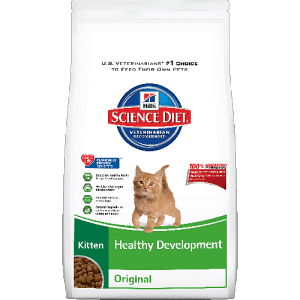
Image courtesy of Hill’s Pet Care
Since 2002, the Hill’s® Food, Shelter & Love® program has donated over $280 million worth of Science Diet brand foods to nearly 1,000 animal shelters, helping over 8 million pets find a new home…and counting. Healthy pets are more adoptable pets and all pets deserve proper, balanced nutrition. The Program also provides a free bag of Science Diet® pet food or a $5 off coupon to the pet parent for each adoption to further ensure a smooth and easy transition for pets to their new
home.
Kitten & Cat Adoption–How to Choose?
Boy or girl? Fluffy longhaired or short-and-svelte coat? Does color matter? What about age? Today there are cats available to suit every taste and circumstance. For a lifetime of love, use both your head and your heart to do some kitty match-making so your lifestyle fits the cat of your dreams, and vice versa.

Even siblings can look very different, and include longhair, shorthair, and a variety of color coats and patterns. Image copr. Amy Shojai, CABC
It’s kitten season, and nothing beats a kitten for cute-icity! There’s no doubt you’ll find your pick of the kitty litters right now. These pictures were taken at a local kitten adoption event, and there were FIVE TIMES the number of furry waifs you see here.
Kittens and cats often choose us. Rather than picking the “prettiest” baby, try this: Sit on the floor quietly in the adoption room, and let the kittens come to you. Roll a wad of paper to see which one pounces (or hides). You want the Christopher Columbus Kitten eager to explore new things–s/he will be healthier and less prone to stress compared to a Shrinking Violet kitten. And of course, get a vet check asap–you want to see bright clean eyes, clean fur, ears and bottom, and playful energy.
While kittens can be non-stop fun, they’re also works-in-progress–and you cannot accurately predict adult temperament. Most kittens love to lap-sit, but many outgrow this behavior. So if you want a lifelong feline lap-snuggler, choose an adult cat with an established personality so you know what you’re getting. You’ll already know that the cat likes or dislikes dogs, other cats, children, lap-sitting, and playing.

Many shelters offer a discount for adopting pairs of kittens. Instant friendship! and they’ll target each other instead of your ankles, win-win for everyone! Image copr. Amy Shojai, CABC
Short fur sheds just as much as the long fluffy kind, but won’t tangle or require as much care on your part. Those longhaired beauties like Persians need combing every single day.
All kinds of speculation abounds regarding behaviors associated with coat color or pattern. None of it has been proven one way or another. However, it is a cat “rule” that dark fur lands on light-colored clothing while light fur magnetically attaches to dark trousers. When a cat has both light and dark fur, like my Seren, owners learn to live with hair and consider it a condiment.

Be prepared for cats to act different once you bring them home. Give shy kitties time to adjust. Image copr. Amy Shojai, CABC
Boy cats tend to grow bigger than girl cats, but as long as they’re spayed or neutered (you’ll want to do this!), the behaviors tend to be similar. Intact males want to baptize everything with sprays of urine, and intact girl cats bring more furry babies into this world after yowling and pestering owners to death.

Sure, the youngest kittens may have cute-appeal, but don’t overlook older kittens or even adults. This is Karma, a few days after he arrived–at 8 months old, he probably wouldn’t have been chosen if at a shelter, since he was “so old.” Image copr. Amy Shojai, CABC
Age matters. While space concerns force shelters to adopt out kittens as early as possible, a cat will have far fewer behavior problems if he stays with mom-cat and siblings until at least twelve weeks old. If you adopt a kitten younger than this, you should either have a friendly adult cat in the house prepared to teach Junior how to be a proper cat–or you yourself must attempt to give these lessons. Cats learn from watching other cats how to groom themselves, use the litter box, scratch the right object, and inhibit clawing and biting during play. Humans fall short as teachers.
Lovely adult cats often get overlooked, but they’ve already learned these basic lessons and make outstanding pets. Due to the overload of animals, too many shelters have arbitrary age limits for euthanasia. Cats aged five and above may be euthanized automatically, even though they could be expected to provide a decade or more of companionship to a loving human owner.

Seren was non-stop fun when she arrived at 4 months old. I never would have imagined we’d still have her–now at age 18! and these last 10 years have been the sweetest of all. Image copr. Amy Shojai, CABC
Older cats tend to be more sedate than kittens, and less inclined to climb curtains, attack toes, or conduct gravity experiments by knocking breakables off high spots. At the shelter, don’t expect adult cats to “sell themselves” the way a kitten would. Remember that they’ve likely just lost their home, are scared and sad, and wondering what they did to make a beloved human go away. They need people to take a second look.
Every Christmas, I received emails and phone cals from folks looking for holiday kittens–at a time of year when furry babies are scarce. Now’s the time to look since a bumper crop abounds and you’ll be saving a life by adopting a cat.

“Happily ever after….” Image copr. Amy Shojai, CABC
You don’t need to wait for Adopt-A-Shelter-Cat Month. Wonderful candidates of all shapes, ages, and sizes wait for you at area shelters all year long. Nineteen years ago, my cat Seren showed up on a friend’s back porch, and purred her way into my heart. And a year ago, Karma-Kat decided to adopt our Magical-Dawg when he tried to dig his way through the patio window. May you be as lucky as my family to find the cat (or three) of your dreams!
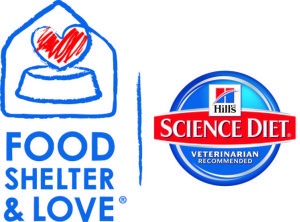
Image courtesy of Hill’s Pet Care
Does your shelter work with the Food, Shelter & Love Program? Use this link to find a shelter partner in your area!
I love hearing from you, so please share comments and questions. Stay up to date on all the latest just subscribe the blog, “like” me onFacebook, and get a FREE BOOK when you sign up for Pet Peeves newsletter. Stay up to date with the latest book give aways, and appearances related to my THRILLERS WITH BITE!
June 24, 2015
NAME THAT DOG & NAME THAT CAT! VOTE Your Pet Name for New Thriller
 I am blown away by the response to the call for pet name nominations to star in my next thriller SHOW AND TELL. After sending out the request in my Pet Peeves newsletter, I also and shared via social media and various email lists.
I am blown away by the response to the call for pet name nominations to star in my next thriller SHOW AND TELL. After sending out the request in my Pet Peeves newsletter, I also and shared via social media and various email lists.
There were a total of 46 dog names suggested, and (wait for it…) 81 cat names suggested. Wow! Some of y’all nominated a name for a specific dog or cat character, while others simply suggested names without a preference.
For simplicity’s sake, though, I’ve had to limit each character/poll to no more than 15 names (sorry!). I tried to include at least one name from each person (some of y’all offered several nominations), and avoid those too similar/already used for human characters. Stay tuned–because I have saved all the suggestions and have planned a special tie-in to include even more pet names. Because after all, EVERY pet is a star!
So without further delay, here are the lists. Feel free to vote for up to 3 in each category, and share this post to encourage your friends to campaign for your dog or cat name. I’ll leave the polls open until July 1st, and announce the winners on July 4th.
So feel free to share this everywhere and campaign for your top picks. The winning names not only will be included in the book, but your name and real pet’s description will be added to the “fact or fiction” acknowledgements in the book, and I’ll send you a paw-tographed copy of the book as soon as it comes out.
I’ve only included the suggested names and brief description (if offered) but if you want to review more details check out the comments on this blog post. Sorry, some came to me privately so can’t share beyond what’s on the poll for those…
But to THANK YOU for voting, scroll on down to the end for links to a couple of free E-books available June 24-26. Ready–set–VOTE!

Images courtesy of DepositPhotos.com
NAME THAT DOG!
Two “hog hunting” dogs that belong to BeeBo (from the HIDE AND SEEK book). They are adult Pit Bull (or pit mix). These dogs (one girl, one boy) adore each other. Vote for up to THREE of the following choices:
Take Our Poll
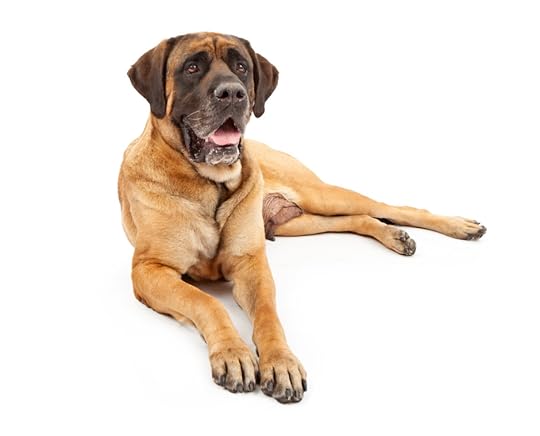
The third dog is a 200-pound Mastiff, lovely docile but powerful dog (and a drooler). Again, vote for up to THREE of your faves.
Take Our Poll

Dog that belongs to Willie Combs, the young son of Detective Jeff Combs. The dog loves to dig and is a fence escape artist addicted to chasing rabbits and squirrels, and of a size that September can carry him/her for a short time. Choose your top THREE favorite names.
Take Our Poll
NAME THAT CAT!
A young rescue kitten, found with a murder victim. It has typical kitten antics and can be any breed or look, and will be the key to catching the bad guy. Choose up to THREE of your favorite names.
Take Our Poll
One of the stolen pets, small enough to fit inside Willie’s jacket and be carried—so could be a small adult or an older kitten, any look/breed. Choose up to THREE of the following names.
Take Our Poll
The third is an adult stolen pet cat, a shoulder perching, Tarzan-leaping, rope climbing maniac cat and can be any age, any breed/look. This kitty will help September and Shadow escape a trap. Pick your top THREE of the following names.
Take Our Poll
FREE FOR THREE DAYS ONLY
JUNE 24-26!
I love hearing from you, so please share comments and questions. Do you have an ASK AMY question you’d like answered–click the banner, above. Be sure to visit my PetHealthyStore for paw-some products for your furry wonders! Stay up to date on all the latest just subscribe the blog, “like” me onFacebook, and get a FREE BOOK when you sign up for Pet Peeves newsletter. Stay up to date with the latest book give aways, kewl product offers, and appearances related to my THRILLERS WITH BITE!
June 21, 2015
AAHA: THE STANDARD OF VETERINARY EXCELLENCE

Image Courtesy of DepositPhotos.com
While I was at the BlogPaws conference last month, I attended a special session sponsored by the American Animal Hospital Association (AAHA.org). Having previously worked as a vet tech, I’m familiar with this organization and learned even more during the presentation by Dr. Heather Loenser. If you’re not familiar with this wonderful organization, here’s what you need to know.
What Is AAHA?
The American Animal Hospital Association, founded 82 years ago, is a voluntary accrediting organization for small animal hospitals in the United States. That’s right…accreditation is VOLUNTARY, and it is not required by law. Only 12-15% of animal hospitals have gone through the rigorous and stringent evaluation process to attain this distinction.
That’s not to say that animal hospitals without AAHA-accreditation don’t offer great care from talented and dedicated veterinarians. Dr. Loenser noted that to achieve accreditation requires cooperation and dedication from the entire staff, from veterinarians and technicians to front desk staff and everyone who has a “paw” in the success of the practice.
It’s not particularly easy to achieve AAHA accreditation, or to maintain it. So when you see the red logo on your hospital door, website or their educational materials, you know they’ve gone the extra mile. These folks hold themselves to a higher standard.
Once accredited by AAHA, the animal hospital gets reevaluated every three years, measured against 900 standards. Some of these standards are mandatory, while others have a bit of wiggle room depending on circumstances.
For example, having a single-use surgery and ventilated isolation area are mandatory. hospital design can vary quite a bit depending on the location, type of building, size of practice and other parameters that are not so black and white.
A few of the other standards include issues related to medical records and even mentoring new graduates, as well as pain management, dentistry, radiology, infectious diseases, anesthesia and surgery. You can see some of these AAHA-recommended guidelines online, too.

Image courtesy of DepositPhotos.com
Value Added Information
AAHA also lists 27 position statements covering everything from analgesics and dangerous animal legislation to declawing, animals in research, wild animals as pets, and THIS:
The American Animal Hospital Association supports the concept of animals as SENTIENT BEINGS. Sentiency is the ability to feel, perceive or be conscious, or to have subjective experiences. Biological science, as well as common sense, supports the fact that the animals that share our lives are feeling, sensing beings that deserve thoughtful, high-quality care. The care that is offered should provide for the animal’s physical and behavioral welfare and strive to minimize pain, distress, and suffering for the animal.
For pet parents of human kids, there’s a “just for kids” section, too. Check out the resources for teaching dog bite awareness and safety, as well as helping kids (and yourself, perhaps) through the loss of a special pet. Be sure to check out the AAHA Pet Owner resources section, too.
Is My Vet Hospital Accredited?
 My veterinary hospital has a website, and on the “about” page it includes the AAHA logo and says this:
My veterinary hospital has a website, and on the “about” page it includes the AAHA logo and says this:
“We voluntarily sought accreditation by the American Animal Hospital Association. This means that we regularly have our practice evaluated by an expert to ensure that we comply with veterinary care standards. And it means that you can be sure your pet is receiving the best possible care, using the latest procedures and technology. Ask us about our AAHA accreditation and how it affects your pet.”
You can also check the AAHA-Accredited Vet Hospital Locator and do a search to see if your vet–or a clinic in your neck of the woods–is listed. If you’re moving to a new home, this is also a great way to help you find your ideal veterinary clinic, one that’s focused on compassionate care and that puts your pets first, just like you do.
If you don’t see the AAHA logo, why not ask about it? Maybe your hospital IS accredited and will make more of an effort to let clients know, when they know how much we care. Educated pet parents and clients make the best advocates for their companion animals, and your veterinarians want to know how much you care. In fact, your interest may be all that’s needed for your clinic to seek accreditation.
Now then…post in the comments. Is your veterinary hospital AAHA-accredited? Do tell!
Note: I was not compensated for this post, and AAHA is not responsible for the content of this blog. From time to time, when I feel information about a cause, product, company or organization is so important for the well being of our special animal companions and those who love them, I simply must share. Opinions expressed are my own.
Stay tuned–the VOTE comes this week for NAME THAT DOG and NAME THAT CAT!
I love hearing from you, so please share comments and questions. Do you have an ASK AMY question you’d like answered–click the banner, above. Be sure to visit my PetHealthyStore for paw-some products for your furry wonders! Stay up to date on all the latest just subscribe the blog, “like” me onFacebook, and get a FREE BOOK when you sign up for Pet Peeves newsletter. Stay up to date with the latest book give aways, kewl product offers, and appearances related to my THRILLERS WITH BITE!
June 15, 2015
Why Dogs Vomit: How to Treat Puppy Vomiting At Home
 Dog and puppy vomiting can be very dangerous for your pet, and while we don’t like to talk about it, pet vomit is a fact of life. Dogs tend to vomit more readily than almost all other animals. (The cats just started snickering . . . )
Dog and puppy vomiting can be very dangerous for your pet, and while we don’t like to talk about it, pet vomit is a fact of life. Dogs tend to vomit more readily than almost all other animals. (The cats just started snickering . . . )
Puppy Vomiting & Dog Regurgitation
There are many reasons why your dog vomits, from innocuous to potentially deadly. Vomiting is the forcible expulsion of the stomach’s contents up the dog’s throat and out of the mouth. However, you should be aware that vomiting is different than regurgitation.
Regurgitation is a passive process without strong muscle contractions. Regurgitation can occur minutes to hours after your pet eats his food, and the expelled material is undigested and may even be tube-shaped like the throat. Cats fed cold canned food may “whoops” it back up very quickly, or dogs that gulp and swallow too fast may regurgitate their food. Mom canids in the wild do this when they return from hunting, in order to feed their pups.
Occasional regurgitation isn’t a cause for concern unless it interferes with nutrition and what you feed your pet. Chronic regurgitation typically is seen in a young puppy. In these cases, regurgitation can cause slow growth, and may be due to a physical problem like megasophagus.
How to Make Dogs Vomit
In cases of poisoning or swallowing dangerous objects, you may need to induce vomiting. Learning how to make puppies vomit can save his life.
Give him some food to dilute the poison, delay its absorption, and for solid objects, may also pad any rough edges. It can be tough to get puppies to upchuck if the tummy is too empty.
Give 3% hydrogen peroxide with an eyedropper, syringe without a needle or even a squirt gun or turkey baster. It tastes nasty and foams, and that combination usually prompts vomiting in about five minutes. You can repeat this dose two or three times, with five minutes between doses.
Syrup of Ipecac is effective for dogs. Ipecac takes longer to work than hydrogen peroxide, though, and the dose should only be given once. Give one teaspoon for dogs less than 35 pounds, and up to a tablespoon for larger dogs.
When nothing else is handy, you can try giving table salt prompts dry, onto the back of the puppy’s tongue. Only give one teaspoonful at a time for little pups or a tablespoonful for adults. Repeat in three minutes if the first dose doesn’t work.
Call the veterinarian for further instructions after the pet has emptied his stomach. If you can’t induce vomiting after a couple of tries, prompt veterinary care is even more important. In cases of suspected poison, take a sample of the vomit with you to the veterinarian to analyze and offer an antidote or other follow-up measures.
Why Dogs & Puppies Vomit
When the “vomit center” of the brain is stimulated, the puppy begins to salivate and swallow repeatedly. Your puppy may seek attention or look anxious. Then, the stomach and abdominal muscles forcibly and repeatedly contract, while at the same time the esophagus relaxes. The puppy extends her neck, opens her mouth and makes a strained gagging sound as the stomach empties.
Vomiting should never be considered normal. Most cases of adult dog vomiting result from gastric irritation due to swallowed grass, eating inedible objects, spoiled or rich food (raiding the garbage, table scraps) or simply eating too much too fast. You can prevent puppies from eating the wrong thing with these puppy proofing tips. Dogs and puppies also may vomit from motion sickness during car rides.
The most common cause of vomiting in dogs is gluttony. Dogs that gorge their food tend to lose it just as quickly, particularly if they exercise shortly after finishing a meal. This type of vomiting isn’t particularly dangerous, but is annoying.
Repeated vomiting, vomiting along with diarrhea, unproductive vomiting, vomiting not associated with eating, and/or the pooch acts like she feels bad before or after the event is a cause for alarm.
Vomiting can be a sign of canine distemper virus or canine parvovirus, which can be prevented by proper vaccinations. In deep chested breeds, unproductive vomiting may be a sign of bloat. Bloat (gastric dilatation and/or volvulus) happens with the stomach swells and potentially twists without emptying and can kill dogs very quickly–big deep chested dogs (German Shepherds like Magical-Dawg) are most prone.
If the vomit contains blood or fecal material, if it lasts longer than 24 hours, or if other signs such as diarrhea accompany the vomiting, contact your veterinarian immediately. For some types of vomiting, home care may be all that’s needed.
Treatment for Vomiting
Slowing down how fast your dog eats relieves mealtime vomiting. Feed in separate bowls to cut down on “competition” eating, or place a large non-swallowable ball in the dish so the dog is forced to eat around it. There now are some very cool “foraging bowls” that can help slow down the gulpers. Meal-feeding several times a day rather than once will also alleviate overeating. A few dogs vomit when they’re excited or fearful.
Vomiting that happens only once or twice isn’t a cause for concern as long as the puppy or dog acts normal before and after. Rest the digestive tract for 12 to 24 hours or so usually resolves the gastric irritation in older pups and adult dogs. But very young puppies and especially Toy-size breeds shouldn’t go without a meal for longer than about six to eight hours, though, so you’ll need vet help with tiny pups. These little guys also dehydrate very quickly which can complicate matters.
Pick up the food bowl and give only small amounts of water. Vomiting makes pups feel thirsty but drinking can upset the tummy even further. So offer water in a syringe every 15 or 20 minutes, or offer an ice cube for her to lick.
You can safely give Pepto-Bismol to manage doggy vomiting. It coats the stomach wall, soothes the upset and the bismuth absorbs bacterial toxins that prompt vomiting. The dose is about ½ to 1 teaspoon per 5 pounds of body weight up to three times a day.
Vomiting may be a sign of serious illness, though. Anytime your pet vomits three or more times in a single day, or two or more days in a row, you should take her to the vet.
What about you? Have your puppies or dogs ever had a scary/dangerous bout of vomiting? Magic got REALLY sick one time with explosive diarrhea and vomiting and turns out he’d caught a “bug” from drinking pond water.
PS: Don’t forget to enter the and get your furry wonder featured in my next book! Entries close on Friday!
I love hearing from you, so please share comments and questions. Do you have an ASK AMY question you’d like answered–click the banner, above. Be sure to visit my PetHealthyStore for paw-some products for your furry wonders! Stay up to date on all the latest just subscribe the blog, “like” me onFacebook, and get a FREE BOOK when you sign up for Pet Peeves newsletter. Stay up to date with the latest book give aways, kewl product offers, and appearances related to my THRILLERS WITH BITE!
June 10, 2015
NAME THAT DOG & NAME THAT CAT! Will Your Pets Star in New Thriller?

Image courtesy of DepositPhotos.com
Those who have followed the September Day suspense thriller series know that with each book I’ve held a contest to NAME THAT DOG and NAME THAT CAT character in the stories. In fact, the winning canine or feline not only gets named, but often the pet’s foibles are incorporated in the story.
 In the first book LOST AND FOUND, the winning dog name was Dakota–meaning “trusted friend”–and came from Caren Gittleman and her lovely Sheltie boy. Raelyn Barclay suggested Bruno and took the second dog name. Patricia suggested the winning cat name Macy for the main character’s pet, and this character has become a mainstay of the series! Finally, Karyl Cunningham’s suggested cat name Simba took the final spot.
In the first book LOST AND FOUND, the winning dog name was Dakota–meaning “trusted friend”–and came from Caren Gittleman and her lovely Sheltie boy. Raelyn Barclay suggested Bruno and took the second dog name. Patricia suggested the winning cat name Macy for the main character’s pet, and this character has become a mainstay of the series! Finally, Karyl Cunningham’s suggested cat name Simba took the final spot.
 The second book HIDE AND SEEK also included four pet names. Marci DeLisle’s winning cat name was Pinkerton (named for his pink nose); Patricia won the second cat name suggestion with Hope–incredibly appropriate, once you’ve read the book! And for the dog names, Patricia was a double winner by suggesting Rocky. And finally, Kristi Brashier won the final dog name with an incredible 805 votes for Trixie, the Golden Retriever therapy dog in the books’ Alzheimer’s unit.
The second book HIDE AND SEEK also included four pet names. Marci DeLisle’s winning cat name was Pinkerton (named for his pink nose); Patricia won the second cat name suggestion with Hope–incredibly appropriate, once you’ve read the book! And for the dog names, Patricia was a double winner by suggesting Rocky. And finally, Kristi Brashier won the final dog name with an incredible 805 votes for Trixie, the Golden Retriever therapy dog in the books’ Alzheimer’s unit.
Now it’s your turn to NAME THAT DOG and NAME THAT CAT!
 SHOW AND TELL: An animal behaviorist and her service dog race a deadly storm to expose a treacherous secret others will kill to protect.
SHOW AND TELL: An animal behaviorist and her service dog race a deadly storm to expose a treacherous secret others will kill to protect.
I’ve just sent out my Pet Peeves newsletter announcing this to my subscribers (they will always get the news first! have YOU subscribed yet?), but always share on my blog, too.
SHOW AND TELL again takes place in the fictional town of Heartland, Texas. When September Day figures out missing pets aren’t lost, but instead stolen to be training bait for dog fights linked to a drug distribution ring, she has 24 hours to save the victims (furry and human). For those who have read the first two books, you’ll be pleased that SHOW AND TELL brings the story full circle. (Okay, that’s enough of a hint!).
For those who have NOT read my thrillers, rest assured that I hate stories where animals are killed for shock value. While my books are suspenseful and thrilling, that is a line I don’t ever cross.
WILL YOUR PET STAR IN “SHOW AND TELL?”
I’d like to begin collecting preliminary cat and dog names to include in the future polls where YOU get to vote and choose the furry stars. You can list a single dog or cat name (please indicate which it is!) or several. I’d love to hear what the pet(s) look like, why they were given that name, and any unique characteristics, behaviors, or history that make them even more special.
Here are the pet characters in the story. But who knows, your suggestions may inspire an added kitty or doggy (or other critter) character to leap into the story, so don’t hold back.
NAME THAT DOG (4 NAMES)
I need FOUR DOG NAMES, as follows:
Two “hog hunting” dogs that belong to BeeBo (from the HIDE AND SEEK book). They are adult Pit Bull (or pit mix). These dogs (one girl, one boy) adore each other and I’ve currently named them “Beggar” and “Dizzy” for their behaviors. That may changed, if your suggestions work better!
The third dog is a 200-pound Mastiff, lovely docile but powerful dog (and a drooler).
The fourth dog belongs to Willie Combs, the young son of Detective Jeff Combs. The dog loves to dig and is a fence escape artist addicted to chasing rabbits and squirrels. I’ve imagined him as a Beagle but am open to breed and looks. He needs to be of a size that September can carry for a short distance.
NAME THAT CAT (3 NAMES)
I need THREE CAT NAMES, as follows:
A young rescue kitten, found with a murder victim. It has typical kitten antics and can be any breed or look, and will be the key to catching the bad guy.
The second is one of the stolen pets, small enough to fit inside Willie’s jacket and be carried—so could be a small adult or an older kitten, any look/breed.
The third is an adult stolen pet cat, a shoulder perching, Tarzan-leaping, rope climbing maniac cat and can be any age, any breed/look. This kitty will help September and Shadow escape a trap.
HOW TO ENTER THE CONTEST
Just post your name suggestions in the comments and I’ll add them to the pot. Share this post with anyone else you think might want to include their pet’s name for consideration. I’ll let you know if your suggestions make the poll list, so you can share with your friends and family to get as many votes as possible.
The winning names not only will be included in the book, but your name and real pet’s description will be added to the “fact or fiction” acknowledgements in the book, and I’ll send you a paw-tographed copy of the book as soon as it comes out.
Ready…set…GO! NAME THAT CAT….and NAME THAT DOG!
I love hearing from you, so please share comments and questions. Do you have an ASK AMY question you’d like answered–click the banner, above. Be sure to visit my PetHealthyStore for paw-some products for your furry wonders! Stay up to date on all the latest just subscribe the blog, “like” me onFacebook, and get a FREE BOOK when you sign up for Pet Peeves newsletter. Stay up to date with the latest book give aways, kewl product offers, and appearances related to my THRILLERS WITH BITE!
June 8, 2015
8 Ways To Hiss Off Your Cat

“You did WHAT???!” All Images courtesy of DepositPhotos.com
We love our cats but still complain about their “behavior problems.” Our blood pressure goes off the charts when cats scratch the furniture, baptize the bed, and caterwaul at 5:00 a.m., even though we’re purr-fect owners!
Our cats love us back. But there’s no doubt that kitty’s tail gets in a knot over a human’s “behavior problems.” Here are 8 common things you do to hiss off your cat.
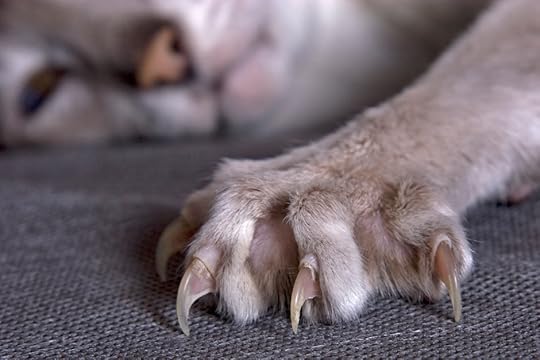
Cats claws are an engineering marvel, and grow from the last bone/digit of each toe.
Clawing Angst: Cats claw to mark territory, to exercise and relieve stress. Owners hiss off cats by not providing the kitty-correct claw object and location. Cats don’t care if it’s color-coordinated to human taste. A nasty-clawed-ugly-old-post with scratch-graffiti is like a child’s favorite binky and can’t be replaced with a spanking-new post. Hiding it away means claw-art won’t be seen. Cats re-train humans by clawing kitty-correct objects of the proper texture and location—like the sofa.
Declawing Growls: Surgical claw removal offends many cats on an emotional and physical level. It strips away normal kitty defenses, and changes kitty stride/balance. Yes, some cats manage to suck it up and soldier on, but others demonstrate hissed-off status by avoiding the litter box (it HURTS to dig with sore toes!), or biting more often in defense. Change in balance and stance may also add to arthritis pain as the kitty ages. Trim claws regularly, and offer legal outlets for normal kitty claw activity to prevent hissy claw fits.
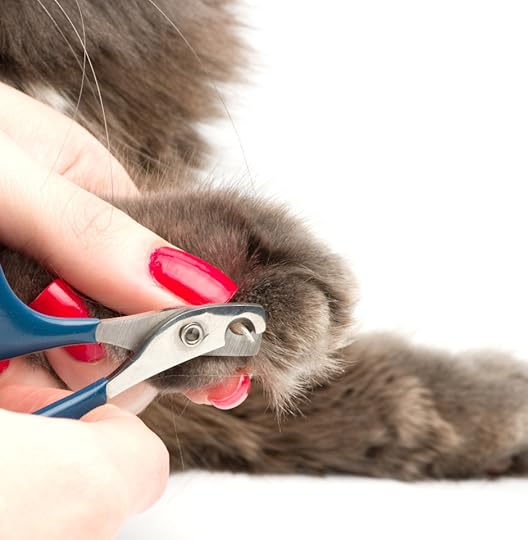
Seren and Karma get their claws trimmed every week or so–in case they “forget” and scratch something, it does no damage.
Litter-ary Woes: Hit-or-miss potty behavior is the top complaint of cat owners—but we bring it on ourselves. Most standard commercial boxes are too small for jumbo-size cats so they hang over the edge or look elsewhere. Kitties hate being surprised in the potty, and dislike strong odors from perfumed litter or stinky deposits—a covered box condenses smells and blocks the view. Do you have a favorite TP? Cats get attached to favorite litter, too, and switching prompts some cats to take their business elsewhere. Having to “share” facilities is like you discovering somebody forgot to flush—ew! Extra boxes will reduce the hiss-quotient for kitties.
 Carried Away: Cats love the status quo. Changes to routine annoy or frightens them. Being stuffed into an unfamiliar cat carrier and then grabbed, poked and probed by scary-smelling strangers (vet alert!) makes cats hit the panic button. Couldn’t the vet at least warm up the thermometer? Savvy kitties teach owners a lesson by disappearing each time we reach for the S’carrier. Make cat carriers part of the furniture and add catnip toys or fuzzy bedding to take the “scary” out of the equation.
Carried Away: Cats love the status quo. Changes to routine annoy or frightens them. Being stuffed into an unfamiliar cat carrier and then grabbed, poked and probed by scary-smelling strangers (vet alert!) makes cats hit the panic button. Couldn’t the vet at least warm up the thermometer? Savvy kitties teach owners a lesson by disappearing each time we reach for the S’carrier. Make cat carriers part of the furniture and add catnip toys or fuzzy bedding to take the “scary” out of the equation.
Left Behind: Vacations hiss off many cats because it messes with feline routines. Your felines get used to being fed, petted, played with, and snuggled at certain times and the owner’s absence throws a furry wrench in kitty expectations. It can take kitty a week or longer to become used to a new schedule of you being gone. Your return disrupts the newly learned kitty schedule all over again, so the cat has a double-dose of kitty angst from owner vacations.

Do your cats wake you?
Sleeping Late: Why would owners want to sleep late, when a kitty bowl needs to be filled? Cats raise a ruckus to point out food bowl infractions or other owner irresponsibility. Felines become quite adept at training us simply with consistent purr-suasion, causing sleep deprivation until we give in.
Indoor Incarceration: Cats that have experienced the great outdoors can become distraught when “jailed” exclusively indoors. Never mind they’re safer indoors away from dangers—closed doors and barred windows drive these cats crazy. Bringing the outdoors inside with puzzle toys, cat towers and a kitty house-of-plenty can calm the feline freedom fighters.
 Unfaithful Owners: Owners may think kitty is lonely and wants a friend, but they never ask the cat! Bringing a new pet (especially a cat) into the house turns up the hiss-teria. How would you feel if asked to share your potty, dinner plate, toys, bed—and love-of-your-life human—with a stranger off the street? To the cat, the interloper looks funny, smells scary, and disrupts that all-important familiar routine. It can take weeks or months for cats to accept newcomers as family members.
Unfaithful Owners: Owners may think kitty is lonely and wants a friend, but they never ask the cat! Bringing a new pet (especially a cat) into the house turns up the hiss-teria. How would you feel if asked to share your potty, dinner plate, toys, bed—and love-of-your-life human—with a stranger off the street? To the cat, the interloper looks funny, smells scary, and disrupts that all-important familiar routine. It can take weeks or months for cats to accept newcomers as family members.
 There are always feline exceptions. Your cat may not have read the kitty rule-book, and perhaps throws hissy-fits over other issues. Understanding what concerns our cats helps us be better owners, and enhances the love we share. And…that’s one of the main reasons for the ComPETability book series, with how-to step by step advice your CATS and DOGS will love!
There are always feline exceptions. Your cat may not have read the kitty rule-book, and perhaps throws hissy-fits over other issues. Understanding what concerns our cats helps us be better owners, and enhances the love we share. And…that’s one of the main reasons for the ComPETability book series, with how-to step by step advice your CATS and DOGS will love!
What have I missed? Do you hiss off your cat, too? How have you adjusted your “bad human behavior” to keep the hissy peace? Do tell!
I love hearing from you, so please share comments and questions. Do you have an ASK AMY question you’d like answered–click the banner, above. Be sure to visit my PetHealthyStore for paw-some products for your furry wonders! Stay up to date on all the latest just subscribe the blog, “like” me onFacebook, and get a FREE BOOK when you sign up for Pet Peeves newsletter. Stay up to date with the latest book give aways, kewl product offers, and appearances related to my THRILLERS WITH BITE!
June 1, 2015
CWA at BlogPaws a Paws-itive Experience!
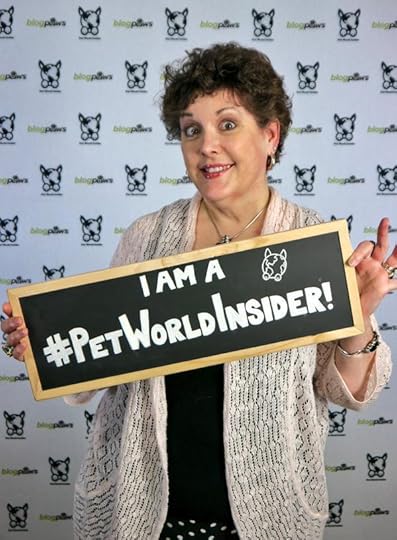 I wrote this fresh off the plane, and am still riding the excitement of a wonderful Cat Writers’ Association partnership with the 2015 BlogPaws Conference. Many folks will share more details but I gotta brag on us just a little. But first a few fun pix to set the mood:
I wrote this fresh off the plane, and am still riding the excitement of a wonderful Cat Writers’ Association partnership with the 2015 BlogPaws Conference. Many folks will share more details but I gotta brag on us just a little. But first a few fun pix to set the mood:
Celebrity Pigs! (…don’t you DARE say it, even if you’re thinking it, LOL!)

Darlene Bryant and friend…
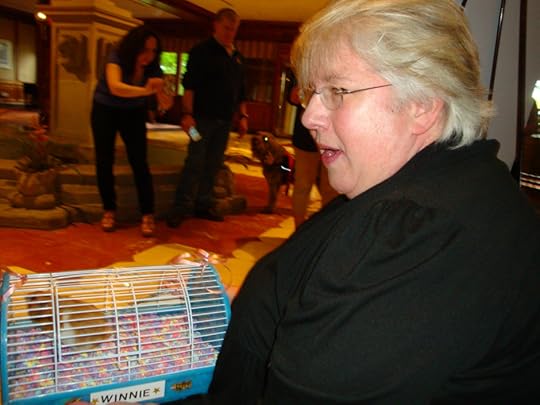
Emmy the Pet Sitter with her hamster friend Winnie!

Teri Thorsteinson’s celebrity cat, Coco. Stylin’ cats rule!

Waiting for TV, and ready for close ups.
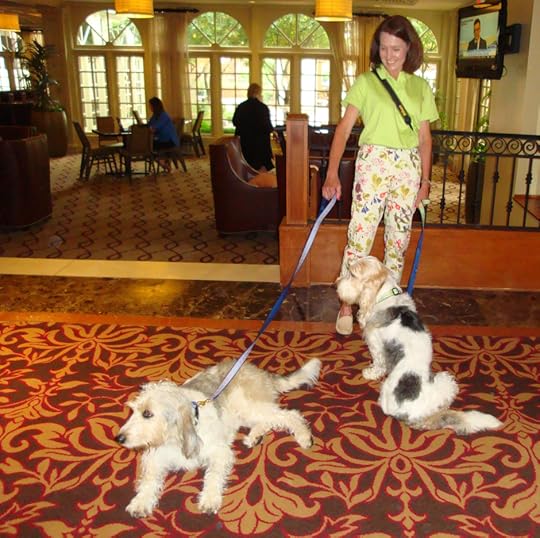
Emma and Bailie with “Mom” from GBGV Life, always kewl to meet in person.

So many Chihuahuas, so much to bark about!

Lon Hodge brings Gander to meet Coco…is that tail wagging?
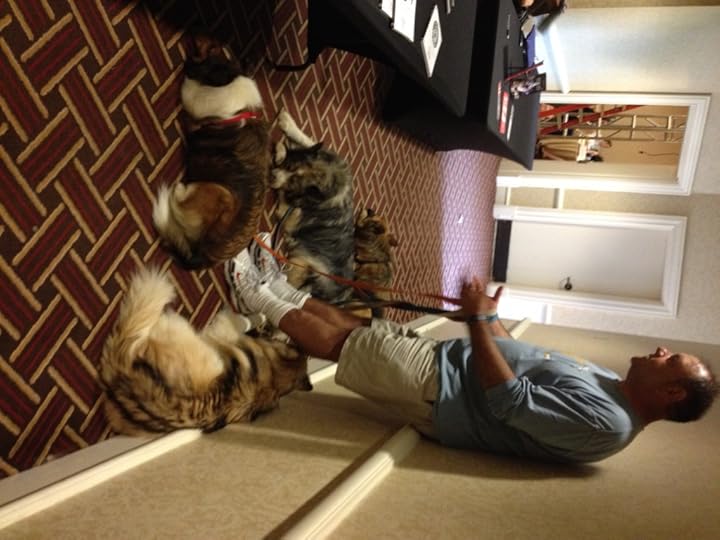
…they’re like potato chips, one isn’t enough.
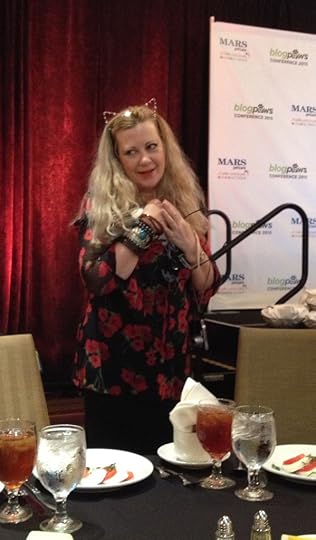
Layla Morgan Wilde at the awards dinner making friends with her dinner companion! (can you see his face, he liked her hair a lot!).
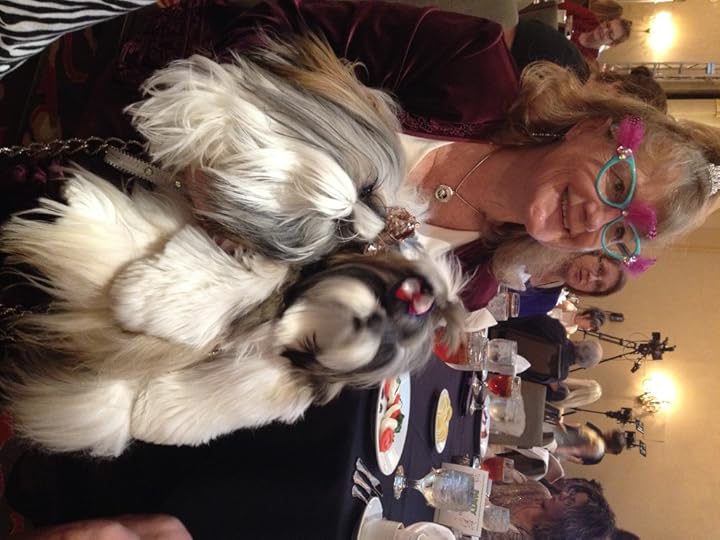
CWA Prez Marci Kladnik at the awards dinner schmoozing with the dressed up dogs at the next table.
Our CWA Writers’ Track Panels were a huge hit! YEEE-HAW! But CWA expertise was everywhere this year…along with many experts in social media, marketing and more. Although I’m one of the “old cats” and have been to dozens of conferences over the years, there’s always more to learn and great new people to connect with. I have a stack of biz cards more than an inch thick to add to my twitter/Facebook connections. I even got to connect again with Robert Semrow, Pet World Insider, in a fun interview (top picture), as well as a fun segment for a new cat treat “experience” (stay tuned, will share when available). Here are some pictures and a quick recap of the BlogPaws experience.
 Both Thursday sessions were filled with very engaged audience members eager to learn more about publishing, good writing, journalistic integrity and more. Publisher/author Bob Mayer, and authors Lisa Erspamer, Pam Johnson-Bennett and myself presented on the first Publishing Panel.
Both Thursday sessions were filled with very engaged audience members eager to learn more about publishing, good writing, journalistic integrity and more. Publisher/author Bob Mayer, and authors Lisa Erspamer, Pam Johnson-Bennett and myself presented on the first Publishing Panel.
 Then CWA members Layla Morgan Wilde, Deb Barnes, Janiss Garza and Alana Grelyak presented on their panel. The audience members kept us with questions long after we were scheduled to stop, and then dozens (yes, I said DOZENS) of aspiring CWA members made their way to the CWA Booth to find out more about our organization.
Then CWA members Layla Morgan Wilde, Deb Barnes, Janiss Garza and Alana Grelyak presented on their panel. The audience members kept us with questions long after we were scheduled to stop, and then dozens (yes, I said DOZENS) of aspiring CWA members made their way to the CWA Booth to find out more about our organization.
That evening, longtime member and CWA booster Steve Dale spoke at the opening ceremonies about one of our favorite causes, Winn Feline Foundation. He not only gave a lovely shout-out to CWA and Lorie Huston (sniff), he presented the Winn Media Appreciation Award to Fran Pennock Shaw. Mee-Wow! A highlight for me on Saturday was lunch with Steve and reconnecting/catching up.
Friday morning’s Keynote, Peter Shankman, had the audience rolling in the aisles. He is an incredibly entertaining and generous speaker, with great insights and information. CWA members will remember he also spoke at one of our conferences in White Plains, NY–and he’s a CAT GUY! Stay tuned, I hear-tell that one of our members got a picture of him wearing cat ears. (Hmnnn, why isn’t he a member yet?!).
Another CWA member, Sandy Robbins, made CWA look fantastic as she spoke on a Keynote Panel on Saturday morning with Harrison Forbes and Laura Nativo about being a celebrity spokesperson.
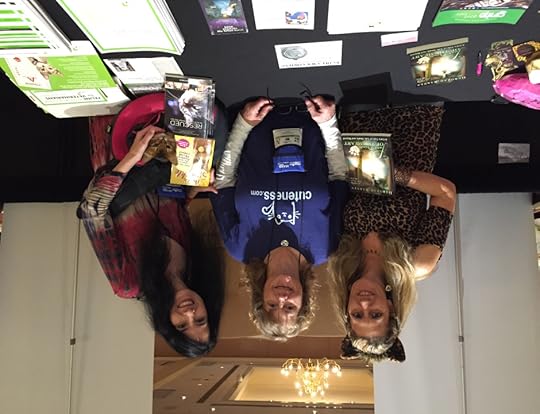
 Wendy Christensen sent 100 copies of her beautifully designed booklet with details about the organization–I came home with only about 20 copies left. Fran Shaw had arranged for CWA members to host the booth where they not only provided great PR for CWA, but they also signed/sold a bunch of their own books. Speakers had a second signing opportunity and we signed quite a few Saturday afternoon, too.
Wendy Christensen sent 100 copies of her beautifully designed booklet with details about the organization–I came home with only about 20 copies left. Fran Shaw had arranged for CWA members to host the booth where they not only provided great PR for CWA, but they also signed/sold a bunch of their own books. Speakers had a second signing opportunity and we signed quite a few Saturday afternoon, too.
Lea-Ann Germinder and her GoodNewsForPets team designed/created two fantastic free-standing banners for the booth that we’ll use at future events. We also created CWA “contest discount” postcards added to the cat “swag bags” hoping to encourage more nonmember cat writers to join our furry throng. That’s right, there are many cat folks at the event but also dog bloggers (horse bloggers, hamster bloggers etc) who also share their lives (and writing) with cats. Hey, we’re all in this together–for the good of ALL pets, right?
 CWA was one of about 50 booths in the exhibit hall, where attendees got to meet all kinds of pet products companies catering to dogs, cats, birds, hamsters, you-name-it. Another whole section (about 25% or so) was dedicated to Kate Benjamin’s “Cat Style Lounge” containing cat-astic feline products.
CWA was one of about 50 booths in the exhibit hall, where attendees got to meet all kinds of pet products companies catering to dogs, cats, birds, hamsters, you-name-it. Another whole section (about 25% or so) was dedicated to Kate Benjamin’s “Cat Style Lounge” containing cat-astic feline products.

The lovely Deb Barnes, Christine Michaels and Dusty Rainbolt at the awards banquet. Deb and Christine were nominees!
The Nose-to-Nose awards this year included seven CWA member nominees, and three CWA members Debbie Glovatsky, Alana Grelyak and Christine Michaels took home awards! What a testament to the quality of our members’ work, right? It also makes CWA look good for those aspiring to make this their chosen career, and also to potential sponsors and other pet professionals. I am so very proud!
All the speakers sessions were great, and I learned a lot. The sponsors outdid themselves. Mark Johnson, the President of Mars Petcare US (presenting sponsor), was there along with Dr. Tiffany Bierer, and a host of other great sponsors including Pet360 of course. Did you notice the CWA logo on that page, too? Yep, we’re listed as a sponsor and got lots of PR from BlogPaws.

That white dog is Nitro from DeafDogsRock.com rockin’ his purple jacket, with my new friend Bernard and the lovely Yvonne Divita.
I can’t say enough good about Yvonne Divita, Tom Collins, Chloe Divita and their team of tireless folks running thither and yon, including Carol Bryant, Felissa Elfenbein, Robbi Hess and I don’t know how many others (please forgive me if I accidentally left out your name!).
Frankly, I had a blast. I also lost my voice. There were so many dogs there, wow, but also more cats and cat-centric folks than have ever attended before. I met one blogger who came from Australia and said the deciding factor to attend was CWA’s presence. That’s humbling. And exciting.

Dusty Rainbolt, Marci Kladnik and Amy Shojai on the red carpet, what fun! Hey…let’s do it again next year!
That’s why I am so very pleased to announce some exciting news–just released to CWA members and so now we’re able to tell the world. The 22nd Annual Cat Writers’ Association Awards Banquet will be held Friday, June 24, 2016 concurrent with the 2016 BlogPaws Conference at the Wild Horse Pass Resort & Spa. Details about all the CWA events will be shared as they become available–and I’d encourage those interested to get in on the early bird rate for BlogPaws so you can double your pleasure!
In closing, I’ll leave you with this…Awwwwwwww!
I love hearing from you, so please share comments and questions. Do you have an ASK AMY question you’d like answered–click the banner, above. Be sure to visit my PetHealthyStore for paw-some products for your furry wonders! Stay up to date on all the latest just subscribe the blog, “like” me onFacebook, and get a FREE BOOK when you sign up for Pet Peeves newsletter. Stay up to date with the latest book give aways, kewl product offers, and appearances related to my THRILLERS WITH BITE!
May 26, 2015
SKUNKED! Solving Skunk Stink

It’s not just clueless puppies that get skunked! Image courtesy of DepositPhotos.com
It happened again—Magical-Dawg found a skunk, at about 6:30 a.m. on Monday. A day later, and the smell lingers in the house. You’d think dogs would learn after one skunk encounter, but time after time he sticks his nose in rude places and gets rewarded with skunky consequences. One summer, he was skunked 3 times in as many weeks, yikes!
How to Solve Skunk Stink
I suspect that the heavy rains have evicted many little black and white furry families from their heir homes. This one Magic found pretty close to the house, rather than the distant field that’s on pretty low (currently soggy) ground. Usually hunting dogs get nailed most often since they’re exposed to wildlife as they hunt. But hungry skunks won’t hesitate to munch pet food left out and can even sneak into your house (yikes!) through a pet door.
My husband has morning dog duty, so he saw it happen—and then decided to bring Magic IN THE HOUSE to tell me about it. Urk! Nothing like eau de wet dog + skunk to start off your morning right. Even Karma-Kat objected, his tiny little nose wiggling and his kitty face wearing an appalled expression.
Once hit, Magic typically rolls around to get rid of the smell. A direct hit in the eyes can cause temporary blindness but he’s been lucky so far. Of course, with all the rain we’ve had, the rolling added wet mud-puppy to the equation.
Why Dogs Get Skunked—Again & Again
Dogs aren’t dumb. Well, most are not…so you’d think they’d learn from one (or two, or five!) encounters. Yet the dogs continue to push the sniff-envelope and continue to get nailed. It’s not entirely their fault, even though skunks give fair warning with stomped feet, turning around and holding the tail high. But this elevated tail poised to launch its smelly cargo sends mixed signals to pets.
A straight-up tail is a greeting behavior for cats, and for dogs a high-held wagging tail begs for a greeting sniff. The skunk has shown the equivalent of a dog offering to shake hands, and gets his feelings hurt when he misunderstands the skunk’s invitation. It’s simple mis-communication.
Why Skunks Stink
Skunks have musk glands on each side of the anus. These glands are equipped with retractable ducts. They can take aim and spray the stink a distance of 10 to 15 feet, so even standoffish pets are liable to get nailed.
Skunk spray contains thiols, an organic compound composed of a sulfur atom attached to a hydrogen atom attached to a carbon atom. The same types of compounds create stinky breath or flatulence. Thiols have a lingering rotten egg odor, and the skunk’s oily secretion makes it difficult to get rid of. Skunk spray is so pungent, a concentration of one in 10 parts per billion can make humans gag. Just think how obnoxious or downright painful the smell is to your pet’s nose.
Eliminating Skunk Odor
A bath alone generally won’t do the job. The oily secretions can be difficult to wash away, and the thiols are impossible to perfume or wash off. Usually a commercial de-skunking solution will be needed, one that incorporates odor neutralizers specially designed to eliminate the pungent aroma. I have on hand some Z Air, a product I’ve loved using around the litter box. Who knew it’d be so effective for skunk smell, too!
Perform clean up outside, too, or you’ll need to deodorize your entire house after scrubbing the pet. Wear comfortable, disposable old clothes and gloves because your dog will transfer odor to you during the bathing process. Trust me on this!
Oh, and do NOT let the dog back into the house until after the bath. Otherwise, you’ll have to deal with the skunk smell in the air and potentially your carpet and furniture when the dog tries to rub off the odor. Currently I’ve got a Fresh Wave candle burning, and a CritterZone odor neutralizer running in addition to spritzing odor neutralizers around the kitchen.
What if you don’t have handy-dandy products available that are designed to keep skunk smell at bay? Here are a few options.
3 Home Remedies for Skunk Stink
Tomato Juice. A tried and true home remedy is a tomato juice soak. Wash your puppy first with pet shampoo and towel him dry. Then douse him with the juice and let it soak for ten or fifteen minutes. Rinse him off and suds again with the regular shampoo. Alternate the tomato juice soak with the shampoo bath until he’s less pungent. Be warned, though, that white and light colored pets may turn temporarily pink from this treatment.
Massengill Douche. Professional groomers often recommend Massengill brand douche to get rid of skunk odor. Mix two ounces of Massengill to a gallon of water for small dogs—double the recipe for bigger pups—and pour over the washed pet. Let the solution soak for at least fifteen minutes. Then rinse with plain water, and bathe with normal shampoo once more.
Chemistry Cure. You can also use chemistry to neutralize the thiols. I like this option so much, I included it in my book The First Aid Companion for Dogs and Cats. Here’s what to do:
Mix one quart of 3% hydrogen peroxide with ¼ cup of baking soda, and one teaspoon of pet shampoo (any kind will work).
Apply to the pet’s DRY fur.
Allow the mix to bubble for three or four minutes.
Rinse thoroughly.
Repeat steps 1-4 until odor is gone.
This recipe, created by chemist Paul Krebaum, works better than anything on the market. You can’t buy it, though, because the formula can’t be bottled. It explodes if left in a closed container. So if your pet is skunked, mix only one application at a time. Otherwise you’ll be cleaning up more than just the pet.
What about you? Has your dog ever been skunked? More than once? How did you solve the stink? I suspect Magic likes the aftermath of getting to play hose tag with the water!
I love hearing from you, so please share comments and questions. Do you have an ASK AMY question you’d like answered–click the banner, above. Be sure to visit my PetHealthyStore for paw-some products for your furry wonders! Stay up to date on all the latest just subscribe the blog, “like” me onFacebook, and get a FREE BOOK when you sign up for Pet Peeves newsletter. Stay up to date with the latest book give aways, kewl product offers, and appearances related to my THRILLERS WITH BITE!
May 25, 2015
Crash Test Dummies, Canine Cars & Safe Travel

I’m nominated for a BLOGPAWS NOSE TO NOSE AWARD for best written blog, SQUEEE!
Today it’s Memorial Day and however you commemorate this day, please be careful. Many will be on the road and perhaps take their dog for a car ride as well. This week I’m traveling to Nashville to the BLOGPAWS conference, and while my Magical-Dawg and the two cats would love to go…well, maybe Seren would object!…none will be making the plane trip or car ride with me.
That said, over 100 dogs will make the trip (plus about a dozen cats and more critters of various species). Magic is SO jealous! But he does get to travel locally and let’s me drive his “Magic-Mobile.”
Dog car safety is my #1 concern with any pet in the car. Pets loose in cars can interfere with the driver, cause distractions and potentially cause accidents. During an accident, they may turn into furry projectiles that injure other human passengers as well as themselves, becoming seriously injured, paralyzed, lost, or killed.

Dogs love to ride! Image courtesy of Depositphotos.com
Currently, the United States has no standards or any tests at all for pet travel products, yet many manufacturers advertise claims of successful testing. Distraction protection is very different from crash protection, and some dog products companies take this responsibility very seriously.
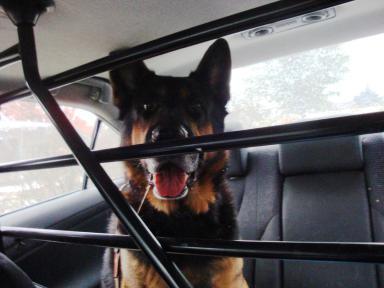
Magic is a car-riding maniac. Image Copr. Amy Shojai, CABC
CRASH TESTS & PET SAFETY
A few years ago I met Linsey Wolko, founder and CEO of the Center for Pet Safety (CPS) at the BlogPaws event, and later interviewed her after Subaru partnered with them in 2013 to study the effectiveness of pet safety harnesses. There were mixed results among some of the most popular pet products on the market touted to provide pet car safety. NOTE: No living dogs were used in these tests, all were conducted with “doggy test dummies.”
The study chose eleven commonly available dog harness products to test that came in Small, Medium and Large sizes and advertised the product having been tested for crash protection. Stuffed dogs served as the test dummies in the three size ranges, which a small 25-pound terrier conformation, a medium 45-pound Border Collie and a large 75-pound Golden Retriever, chosen to best mirror the conformation and weight of living dogs.
MGA Research Corporation, a National Highway Traffic Safety Administration (NHTSA) contracted test facility in Virginia, performed independent, third party testing of the harness products. A minimum standard of performance was first tested, and the seven dog harnesses that passed went on to the “crash” phase of the test with the stuff dog dummies.
The tests were created to result in a worst-case potential for injury. For instance, positioning the test dog dummy in a sit position increased the rotation/force in the crash. “The primary goal was to see if we can keep the dog on the seat,” says Wolko.
The “crash test” takes into account the potential “launch” of the dog from his perch on the car seat, rotation force, as well as how well (or not) the harness prevents doggy injury. Some tests not only resulted in catastrophic failure of fasteners and caused severe harness deformation/stitching failure, but also launched the test-dummy dog, stripped off the harness, or hung/strangled the test dummy. Shedding of the harness/leash also leaves the dog open to escape/becoming lost immediately after the accident.
Only ONE of the eleven company’s products passed the test with a five-paws-up ranking. See the results of the tests here. The Sleepypod ClickIt Utility Harness received Top Performer of those products tested. It controlled both launch and rotation of the test dummy dog in all three Small, Medium and Large product sizes.

Image courtesy of Kurgo
I am not being compensated for writing this post. Kurgo provided me with a free harness in exchange for an honest review. Kurgo is not responsible for the content of this article.
WHAT ABOUT BIG DOGS?
I wanted to find a safety harness for Magic–but the Sleepypod product didn’t come in a large enough size. The one that seemed the best fit, Kurgo harness, initially failed this 2013 test, but the company was one of several that decided to improve the design and enhance quality control.
So I was DELIGHTED recently to be offered a free Kurgo harness to review with Magic, especially since more recent tests show effective safety with its use. The materials and workmanship are impressive, and the company really takes safety seriously. Unlike some other products, this isn’t simply a converted walking harness. Kurgo uses the same type of engineering design used by rock climbers who rely on buckles and tethers to keep them safe.
That said, because it has a ring on the front chest plate, the Kurgo Enhanced Strength Tru-Fit Harness works like a no-pull harness and turns your pup around if he does try to tug you along. (Yes, Magic, I’m talking about YOU!). Fit is important, of course, and for the Kurgo, you simply measure the neck and chest girth to determine the fit.

Image courtesy of Kurgo.
I liked having five places to adjust fit on Magic. However, the neck band at its smallest girth still ran loose on my GSD, but the company offers instructions how to make a DIY adjustment that worked like a charm. It’s also machine washable–kewl! Price ranges according to size, starting at $22 for the little guys and going up to $32 for the largest harness.
The chest pad reduces stress on the trachea and sternum and in the case of dangerous crashes, this spreads the force across the dog’s chest to reduce injury due to localized impact. The harness comes with a carabiner to attach the harness to you car seatbelt system. There’s also a 10-inch dog seat belt tether to allow more range of movement.
CRASH TESTS
The Kurgo Enhanced Strength Tru-Fit Smart Harness and its steel Nesting Buckles has been tested in both tensile strength, static line test, and finally in a crash test using a sled test (see video, below).
Dog Harness Crash test videos show a 50-lb dog (dummy) traveling at 30 miles per hour. The test was conducted and recorded at the University of Michigan, an accredited National Highway and Transportation Administration lab, using Federal Motor Vehicle Safety Standard (FMVSS) 213 for child restraint systems.
Magic weighs nearly 90 pounds so I wouldn’t expect the test dog at this weight to be the same result. And nope, I hope that I will NEVER find out how good this harness is by having Magic in a crash with me. However, it’s the best option I’ve found for him when we’re on the road.
For pet owners of smaller cats and dogs, the absolutely best safety tip I can offer is to secure your small pet inside a carrier and seat belt the carrier into the back seat. Wolko recommends placing the carrier on the floor in the back seat, which works well for the smallest carriers.
As with harnesses, there are no required tests or standards that define “safe pet carriers.” Plastic can shatter, metal can buckle, so conduct due diligence in choosing your carrier. Remember that air bags that go off have enough power to crush and severely injure or kill a small pet.
For big dogs like my Magical-Dawg that won’t fit in a carrier, I have him secured behind a dog gate so he doesn’t try to drive. Now I can also secure him with his Kurgo harness. That keeps him out of my hair and from trying to push the gas pedal, too.
Of course, with hot weather soon to arrive here in North Texas, Magic won’t be car riding as much as he’d like. But now we’re prepared. What about you? Do your fur-kids enjoy car rides? How do you keep them safe? DO tell!
I love hearing from you, so please share comments and questions. Do you have an ASK AMY question you’d like answered–click the banner, above. Be sure to visit my PetHealthyStore for paw-some products for your furry wonders! Stay up to date on all the latest just subscribe the blog, “like” me onFacebook, and get a FREE BOOK when you sign up for Pet Peeves newsletter. Stay up to date with the latest book give aways, kewl product offers, and appearances related to my THRILLERS WITH BITE!










